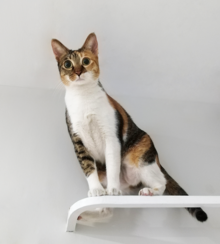
Back قط كاليكو Arabic Kaliko pişiyi AZ Рыска BE Gat calicó Catalan ཀ་ལི་ཀོ་བྱི་ལི་ DZ Γάτα κάλικο Greek Gato calicó Spanish Kalingurmustriga kass ET Chat calico French חתול קליקו HE




A calico cat (US English) is a domestic cat of any breed with a tri-color coat. The calico cat is most commonly thought of as being 25% to 75% white with large orange and black patches; however, they may have other colors in their patterns. Calicoes are almost exclusively female except under rare genetic conditions.
A calico cat is not to be confused with a tortoiseshell, who has a black undercoat and a mostly mottled coat of black/red or blue/cream with relatively few to no white markings. However, outside North America, the calico pattern is more commonly called tortoiseshell and white.[1] Calicoes with diluted coloration (blue tortoiseshell and white) have been called calimanco or clouded tiger.[2] Occasionally, the tri-color calico coloration is combined with a tabby patterning, called tortoiseshell tabby with white. A calico-patched tabby cat may be referred to as caliby.[3]
Derived from a colorful printed Calico fabric, when the term "calico" is applied to cats, it refers only to a color pattern of the fur, not to a cat breed or any reference to any other traits, such as their eyes.[4] Formal standards set by professional and show animal breeders limit the breeds among which they permit registration of cats with calico coloration; those breeds are the Manx cat, American Shorthair, Maine Coon, British Shorthair, Persian cat, Arabian Mau, Japanese Bobtail, Exotic Shorthair, Siberian, Turkish Van, Turkish Angora, and the Norwegian Forest cat.
Because the genetic determination of coat colors in calico cats is linked to the X chromosome, calicoes are nearly always female,[5] with one color linked to the maternal X chromosome and a second color linked to the paternal X chromosome.[4][6] In most cases, males are only one color (for instance, black) as they have only one X chromosome. Male calicoes can happen when a male cat has two X chromosomes (Klinefelter syndrome, with XXY sex chromosomes and generally they are sterile); the condition is a chimera, with two different cell types.[7]
Some calico cats, called "dilute calicoes", may be lighter in color overall. Dilutes are distinguished by having grey (known as blue), cream, and gold colors instead of the typical colors along with the white.
- ^ Sayer, Angela 1996. Encyclopedia of the Cat. London: Chancellor Press, p219. ISBN 1-85152-923-3
- ^ Bojo, Amy (9 June 2020). "How To Tell Difference Between Calico, Tortie, Torbie, Tabby Cats and Kittens". lovemeow.com.
- ^ Cat Colors FAQ: Common Colors - Torties, Patched Tabbies and Calicos :Archived 5 October 2011 at the Wayback Machine
- ^ a b Robinson, Richard. "Mosaicism". Genetics. New York: Macmillan Reference USA, 2003. 76-80.
- ^ Trent, Courtney (16 March 2022). "Are All Calico Cats Female". Wind Haven Ocicats. Retrieved 10 April 2022.
- ^ "Calico cat". Encyclopædia Britannica. Retrieved 5 December 2014.
- ^ Malouf, Najla; Benirschke, K.; Hoefnagel, D. (1967). "XX/XY Chimerism in a Tricolored Male Cat". Cytogenetic and Genome Research. 6 (3–4). Cytogenetics: 228–241. doi:10.1159/000129944. PMID 6035565. Retrieved 22 June 2020.